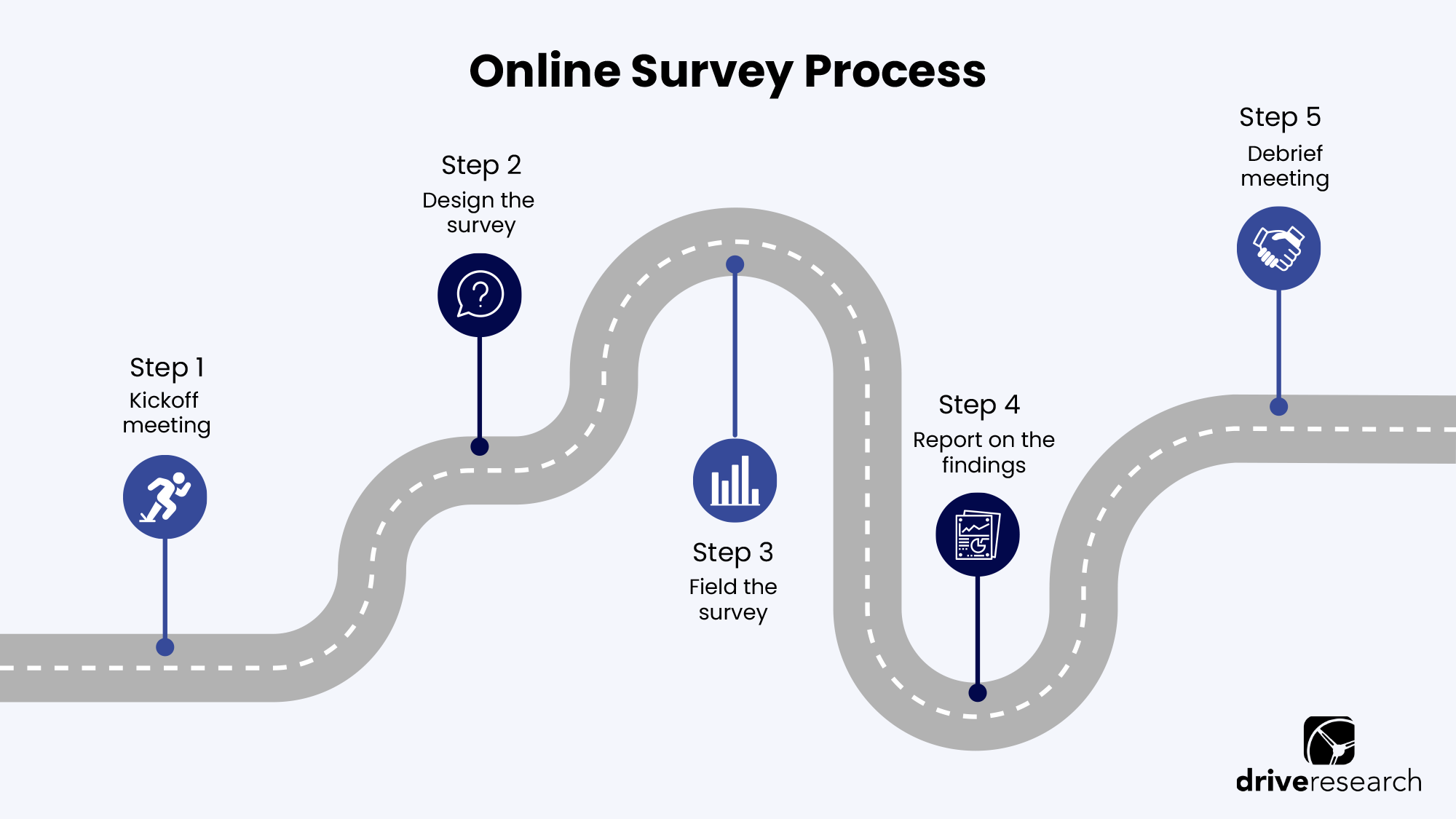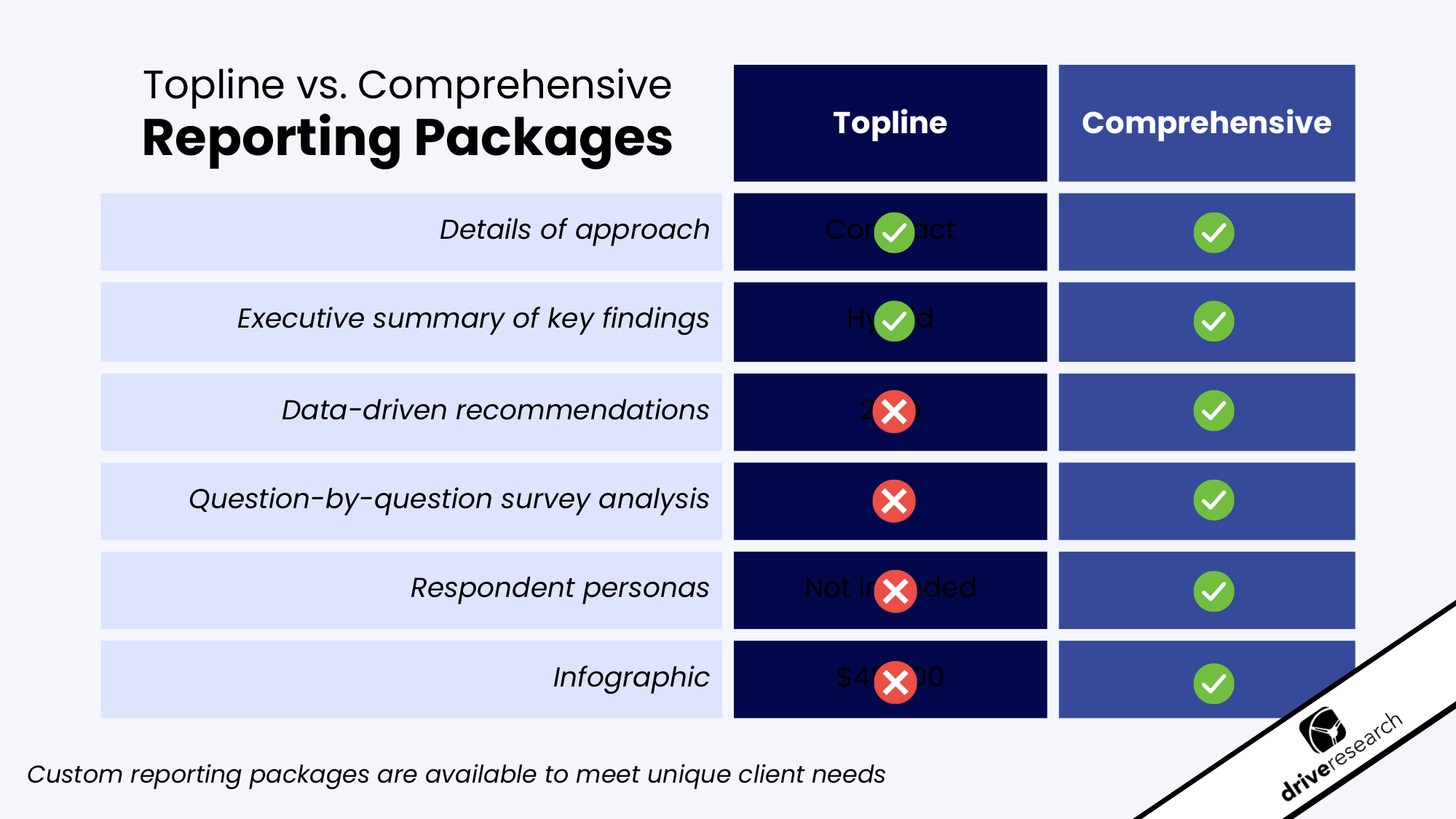
Online surveys have revolutionized the way data is collected and insights are gathered in today's digital world.
Whether you're a researcher, business owner, or marketer, the ability to reach a diverse audience and gather valuable feedback through the convenience of the Internet is invaluable.
In this blog post, our market research company discusses the essential steps of conducting effective online surveys.
We'll begin by exploring what online surveys are and the different types they can take, providing a solid foundation of knowledge. Plus we'll share real-world examples of executing online surveys, giving you practical insights into the process.
Looking to conduct an online survey with a third party? Contact our online survey agency for end-to-end project management. Simply fill out a form on our website or email [email protected] with your project details.
What is an Online Survey?
An online survey is a research method used to collect data and opinions from a targeted audience over the Internet.
It involves designing a set of questions or statements and distributing them through various online platforms, such as websites, email, social media, or mobile applications.
Respondents can access the survey using their computers, smartphones, or other internet-enabled devices.
Benefits of Conducting Online Surveys
When it comes to data-driven decision-making there are hundreds of types of market research to choose from. Although, conducting online surveys is perhaps the most popular. And for good reason.
Online surveys offer several advantages over traditional survey methods, including:
- ✅ Convenience: Respondents can complete the survey at their own convenience, without the need to travel or meet face-to-face with the researcher.
- 🌎 Wider reach: Online surveys can reach a wide audience, potentially including people from different geographic locations or demographic groups.
- 💸 Cost-effectiveness: Compared to traditional paper-based surveys, online surveys can be more cost-effective as they eliminate the need for printing, postage, or manual data entry.
- ⚡ Speed: Online surveys can be conducted quickly, and data can be collected and analyzed in real-time, allowing researchers to obtain results faster.
- ❓ Flexibility: Researchers can use various question types, including multiple-choice, open-ended, rating scales, and more, to gather both quantitative and qualitative data.
- 🔒 Anonymity: Online surveys can offer participants the option to remain anonymous, encouraging more honest and candid responses.
Recommended Reading: Online Surveys vs. Phone Surveys - Which is Better for Your Business?
Types of Online Surveys
There are several types of online surveys that can be used to gather specific data points or insights. It all comes down to what your objectives and goals are.
For example, if your goal is to collect insights to fuel marketing campaigns then ad concept testing surveys are likely the best fit. Whereas, if you are looking to understand satisfaction among your buyers, then conducting customer satisfaction surveys is your best bet.
Here are some common types of online surveys based on various objectives:
- Customer satisfaction surveys: A feedback tool used by businesses to measure the level of satisfaction or dissatisfaction customers have with their products, services, or overall experience. It typically involves asking customers a series of questions to gather insights and identify areas for improvement.
- Employee engagement surveys: These surveys assess employee satisfaction, motivation, and engagement within an organization. They often cover topics such as work environment, communication, job satisfaction, career development, and overall organizational culture.
- Marketing surveys: From brand awareness surveys to campaign evaluation surveys, there are several ways to utilize online surveys to fuel data-driven marketing strategies.
- Event feedback surveys: These are questionnaires distributed to attendees after an event to gather feedback and insights about their experience. They aim to assess various aspects of the event, such as organization, content, speakers, logistics, and overall satisfaction, in order to make improvements for future events.
- Website or user experience surveys: These surveys help website owners or designers collect feedback on website usability, navigation, design, and overall user experience. They can include questions about ease of finding information, website performance, and user satisfaction.
- Product feedback surveys: These surveys are designed to gather feedback and insights from customers about a specific product or service. They aim to assess customer satisfaction, identify areas for improvement, and gather suggestions or recommendations to enhance the product's features, functionality, or user experience.
7 Steps to Creating Online Surveys
Not all online survey projects are the same, but each shares similar process characteristics. For the most part, our online survey company follows a related process flowchart of kickoff to design to fieldwork to reporting.
However, you might find that each new online survey project provides new challenges and hiccups that force you to adjust your process on the fly.
Therefore, working with a market research company that is flexible and responsive like Drive Research is essential. Having an idea about the next steps in the online survey process helps everyone adjust strategies accordingly.
The process of conducting an online survey includes the following steps:
- Determine your objectives
- Request a quote from online survey providers
- Meet with the online survey team
- Design and program the survey
- Distribute the survey
- Analyze the findings
- Debrief on the results
Let's dive into each of these steps in more detail.

Step 1. Determine your objectives
At the first stage of any market research project, it is crucial to clearly identify the purpose of your survey.
For instance, when conducting online surveys, first determine the specific information or insights you hope to gather, whether it's customer feedback, market research data, or opinions on a particular topic.
Setting clear goals and objectives from the beginning will help you uncover the exact type of results you are hoping for.
Step 2. Request a quote from online survey providers
Next, select a reliable online survey company that suits your needs.
Before choosing a market research company to conduct your online survey, you will likely earn several proposals or quotes from different vendors.
When you receive a market research proposal for your online survey, you can expect to learn more about the process, timeline, and costs.
Also look for features such as customizable survey design, question types, data analysis capabilities, and options for survey distribution.
Step 3. Meet with the online survey team
After selecting your online survey provider, the third party will host a kick-off meeting to discuss the intricate details and objectives of the project.
The online survey firm may ask questions such as:
- Who is your target audience?
- What are you hoping to learn from the data?
- How will you use the data?
- How many survey responses do you need?
- How many questions would you like to ask?
It is okay if you don’t know the answers to these types of questions just yet. The market research company can offer their expert recommendations.
Step 4. Design and program the survey
Conducting an online survey project is front and back-loaded, meaning the majority of a market research company’s time is going to be spent designing, programming, and testing the online survey on the front end.
Conversely, on the back end, there is a lot of work during data cleaning, analysis, and reporting (as we will discuss later in this post).
Designing the survey
Once the kick-off meeting is over, the survey analyst will draft a list of survey questions and formats for your team to review.
This is your chance to share any comments, suggestions, or concerns before the survey goes live.
Programming and testing the survey
After your team approves the survey document, the research company will program the survey.
Next, the analyst will test the online survey to assure it is working as intended. A third-party will also make sure the online survey is both mobile and desktop friendly.
Our online survey company also gives our clients the chance to test the survey so they can view the study from the eye of a respondent.
To learn more about programming an online survey, watch this 1-minute video.
Step 5. Distribute the survey
Other than monitoring fieldwork and answering any technical questions from survey respondents once the online survey is "live" and running, the data collection period is straightforward.
Our online survey firm recommends soft-launching a questionnaire first. In other words, instead of sending your survey to all 1,000 respondents, it is beneficial to only send it to a smaller sample of respondents.
Although a survey is tested many times before reaching the fieldwork stage, this step validates responses are being measured correctly.
Once everything checks out, the survey will be distributed to the remaining sample until the goal number of responses is reached.
Step 6. Analyze the findings
After fieldwork is closed, the real fun begins. The online survey company will analyze and break down the data to draft a market research report.
Drive Research offers our clients the choice between a topline or a comprehensive report.
A topline report shares key findings and highlights from an online survey, while the comprehensive report gets into the nitty-gritty details.

Step 7. Debrief on the results
The online survey company will share the market research report with your team to review.
As a next step, they will schedule a debrief meeting to walk through the report page by page. It is important to our market research company that our clients truly understand the findings of the study.
Charts and graphs mean nothing if you cannot understand the data that they represent. For this reason, Drive Research offers recommendations and explanations for how to use these actionable insights.
Example of Conducting an Online Survey
The best way to learn how an online survey project works with a third party is by outlining a real-world example.
Our market research company recently partnered with a web services provider to conduct an online survey. In this section, we will discuss the objectives, process, and outcomes of this research study.
Objectives of the online survey
The web services solution provider hired Drive Research to survey targeted information technology decision-makers and influencers (ITDMs) at organizations based in the U.S.
The proprietary study for the client focused on:
- Software usage
- Purchasing behaviors
- Consumption models
- Presumed cost and time savings
Also, the survey measured trends driven by COVID-19, features, before and after usage benefits, and the value proposition of the client’s solution.
The results will be used as part of a public relations (PR), sales collateral, and content strategy to grow brand awareness.
Executing the online survey
Drive Research recommended using a custom PR survey to collect feedback from ITDMs throughout the country. PR surveys have a multitude of benefits for brands looking to grow awareness among business audiences.
The survey took an average of 15 minutes to complete and included 41 questions.
This approach offered the client a cost-effective solution to quickly gather quality data.
Compared to other methodologies such as phone or mail surveys, the online survey is the best approach to earning a strong ROI.
How were survey responses collected?
The survey was fielded through a panel marketplace of business respondents. It collected 500 responses from the targeted and qualified audience. Additional responses were removed, which did not meet the data quality controls.
Example online survey questions
When conducting online surveys with Drive Research, each questionnaire is custom-written. We do not apply the same survey template to each project. Every client is unique, therefore their survey questions should be too.
In this online survey project example, the IT decision-makers were asked to answer survey questions such as:
- How likely are you to recommend [INSERT CLIENT NAME] to a friend or colleague? Select a rating.
- Describe your experience using [INSERT CLIENT NAME].
- What were your top initial barriers or concerns before using [INSERT CLIENT NAME] for the first time?
- Which of the following categories of software and services have you purchased in the past from [INSERT CLIENT NAME], and which do you plan to purchase in the future?
- Please compare your experiences when purchasing from [INSERT CLIENT NAME] and purchasing from other sources.
- Think about your typical IT purchasing process for cloud computing software and services. How many hour(s) do each of the following take when you use [INSERT CLIENT NAME] /do not use [INSERT CLIENT NAME]?
Online survey results
Although the key results of the online survey remain private with the web services provider, the study was successful in providing our clients with the data they needed to fuel PR and content marketing strategies.
The reliability of this data is high for a highly specific business audience. As intended, all respondents influenced decisions or made purchases for information technology (IT).
Based on the title of the respondent and the size of the organization, all survey respondents made decisions or purchases for a variety of other departments and teams as well.
In addition, all online survey respondents were required to have used the client’s web services solutions.
Other details of the online survey:
- Fieldwork for the survey began on July 3 and lasted until August 18, 2020.
- At the 95% confidence interval with a probabilistic sample, the margin of error for these results is +/- 4%.
- If the surveys were conducted with another 500 random respondents, results would yield within +4% or -4% of the totals 95 out of 100 times.
Frequently Asked Questions About Online Surveys
How long does an online survey project take on average?
Many online survey projects will only run for two weeks or less. Although, the vast majority of online survey completes are received in the first 24 to 48 hours of launch. Additionally, reminder emails will provide you with a bump in response rate, but it is minimal compared to what you will receive on the initial invite.
How are online surveys conducted?
To conduct an online survey, researchers typically use specialized online survey platforms or software that provide tools for survey creation, distribution, and data analysis. These platforms often offer features like customizable design options, respondent tracking, and data export capabilities, making the survey process more efficient.
What are the do's and don'ts in conducting a survey?
By following these do's and don'ts, you can ensure a well-designed and effective online survey that respects respondents, generates reliable data, and yields valuable insights:
- ✅ Do keep your survey clear, concise, and focused
- ✅ Do offer anonymity and confidentiality options
- ✅ Do test your survey before launch
- ❌ Don't use jargon or complex language
- ❌ Don't include biased or leading questions
- ❌ Don't neglect to follow up and express gratitude
Contact Our Online Survey Agency
Drive Research is a national market research firm. Our experts execute online surveys from project kickoff to reporting. Have a question about your next online survey project? Contact us through any of the four ways below.
- Message us on our website
- Email us at [email protected]
- Call us at 888-725-DATA
- Text us at 315-303-2040

Emily Rodgers
A SUNY Cortland graduate, Emily has taken her passion for social and content marketing to Drive Research as the Marketing Manager. She has earned certificates for both Google Analytics and Google AdWords.
Learn more about Emily, here.

